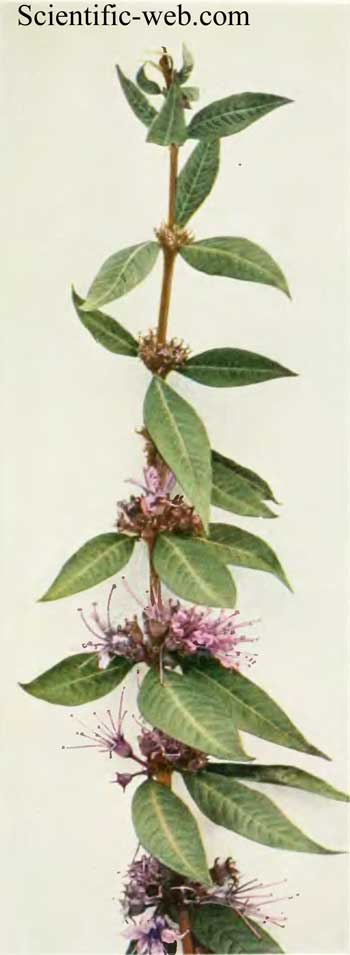
Decodon verticillatus
Classification System: APG IV
Superregnum: Eukaryota
Regnum: Plantae
Cladus: Angiosperms
Cladus: Eudicots
Cladus: Core eudicots
Cladus: Rosids
Cladus: Eurosids II
Ordo: Myrtales
Familia: Lythraceae
Genus: Decodon
Species: Decodon verticillatus
Name
Decodon verticillatus (L.) Elliott
References
A Sketch of the Botany of South-Carolina and Georgia, A 1:543. 1821
USDA, ARS, Germplasm Resources Information Network. Decodon verticillatus in the Germplasm Resources Information Network (GRIN), U.S. Department of Agriculture Agricultural Research Service. Accessed: 07-Oct-06.
Decodon verticillatus, the sole species in the genus Decodon, is a flowering plant in the family Lythraceae. It is commonly known as waterwillow or swamp loosestrife. It is native to wetlands in the eastern half of the United States and Canada.
Description
Typical arching habit of Decodon verticillatus.
Waterwillow is a clump-forming shrubby perennial that grows in swamps or shallow water. The stems are arching, angular, smooth and woody near the base, and up to eight feet (2.4 m) tall. They sometimes root at the tip when they bough over and touch the mud. The leaves are lanceolate, either in opposite pairs or in whorls of three or four. They are up to five inches (130 mm) long and one inch (25 mm) wide, smooth above and hairy beneath, on very short stalks. The rose-pink flowers grow in axillary clusters. The calyx is cup shaped, the corolla under one inch (25 mm) wide with usually five petals narrowing at the base. The ten stamens are projecting with five longer than the rest. There is one pistil, one style and a superior ovary. The fruit is a spherical dark brown capsule with numerous reddish seeds. Flowering takes place in June and July.[1][2][3]
Habitat
Waterwillow is found in swampland, in ditches, besides streams and in shallow water at the edges of ponds and lakes. It often forms thickets and occurs in the United States from Maine to Florida and west to Minnesota, Tennessee and Louisiana, as well as in eastern Canada.[4]
Fossil record
Seeds of Decodon from the late Campanian (73.5 MA) of northern Mexico is the earliest fossil record of the genus.[5] Seeds of the genus are known in Europe from Pliocene to lower Pleistocene. These seeds are assigned to an extinct species, D. globosus. A seed very similar to the modern American species has been found in sediments from Ipswichian in Ireland, and it is possible that the plant survived until the last interglacial in western Europe.[6]
Associated species
The larva of the hydrangea sphinx, Darapsa versicolor, feeds on waterwillow.[7]
The larva of the waterwillow stem borer moth, Papaipema sulphurata, feeds on waterwillow.[8]
References
Homer D. House, Wild Flowers Of New York University of the State of New York, 1918
Water Willow (Decodon verticillatus). Northern Prairie Wildlife Research Center]
Biota of North America Program, 2013 county distribution map. Bonap.net (2014-12-15). Retrieved on 2016-01-22.
Swamp Loosestrife; Willow-Herb – Decodon Verticillatus. Chestofbooks.com. Retrieved on 2016-01-22.
Fossil Records in the Lythraceae Graham, Shirley A. The Botanical Review79.1 (Mar 2013): 48-145.
Godwin, Harry (1975). The History of the British Flora: A Factual Basis for Phytogeography (2 ed.). Cambridge University Press. p. 207. ISBN 0-521-20254-X.
Oehlke, Bill. Darapsa versicolor (Harris, 1839) Choerocampa versicolor Hydrangea Sphinx. silkmoths.bizland.com
Endangered Species/Biodiversity Conservation. Lloyd Center for the Environment
Retrieved from "http://en.wikipedia.org/"
All text is available under the terms of the GNU Free Documentation License

